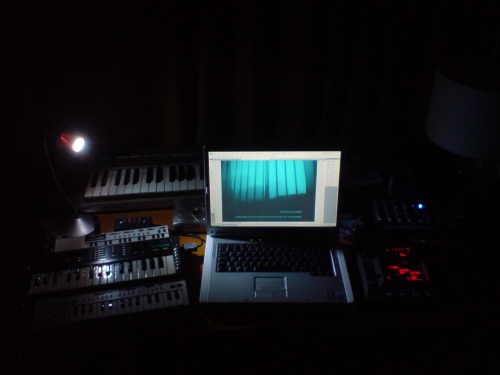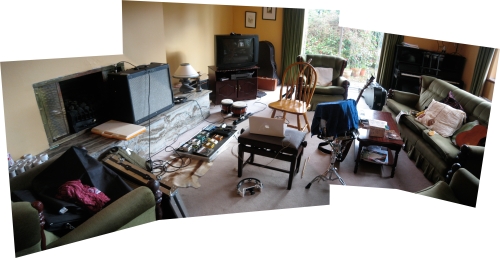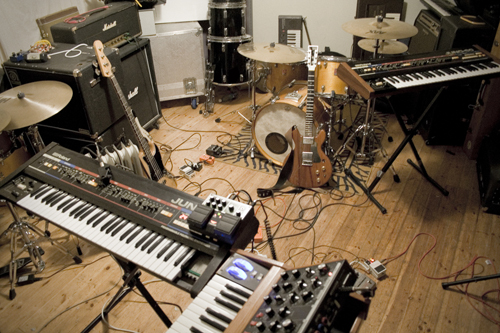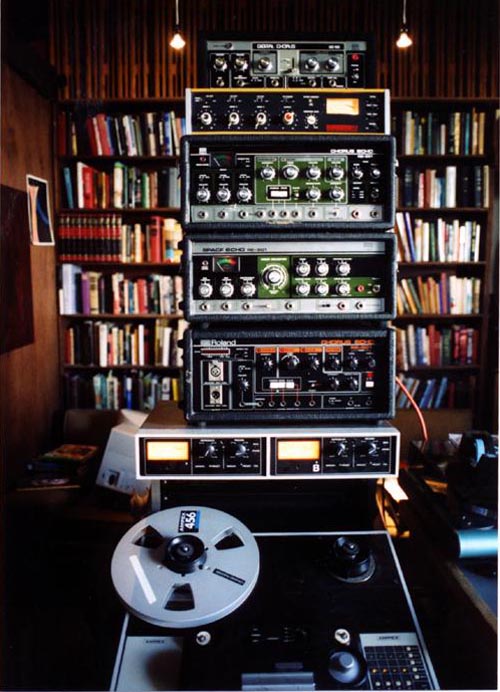My favorite space to create music in is in my room in San Francisco, on 14th St. The building I live in was uprooted and moved from a place called Dolores Park after the great earthquake of 1906. It’s quite small, but that’s fine – I crawl around among the wires like an ant. I have a lot of light, natural daylight. There are three bay windows, so I watch the sunrise in the east and set in the west, like at home, only eight hours later. It smells of an old gold rush San Francisco. The front door has a leaver at the top of the stairs that opens the door. This is quiet common in SF. It was built for the lazy, or for shooting the sheriff if he were to ever rap upon your door.
Most of my musical arsenal is still in Ireland (although I had to sell a lot of it to fund this self-indulgent trip). Having said that, new instruments bring new sounds, new ideas. I currently work with the following gear:
1. Moog Opus III
2. Moog Sonic Six
3. Vox Continental Organ
4. Matel Synsonics Drum Machine
5. WEM Tape Echo
6. SP-404 Sampler
7. Fostex 80 ¼ 8 Track Reel to Reel recorder
8. Other Bits and Bobs
9. Old Reliable – My Fender Jazzmaster
10. Laptop
11. A broken Oscillator
12. A Electromyometer (its measures sound waves made by skeletal movements)
13. Lots of vintage lamps (on loan)
The most important thing for me to have in that space is my ever fluctuating musical thought. I have to strike a machine up to get it going, but when it does it can go either way; really great, or absolutely terrible. I have to catch it when it’s in a good mood. I swim a lot so that helps wash out the cobwebs and demons that lurk beneath. Walking helps too. If it were a physical thing, I guess it would be my guitar. It often acts a starting point, so it’s good to always close to the source. Sunlight; a foreign concept of an Irish expat. Abstraction.
I spend 90% of my time here. I have always been a bedroom dweller. I think Brian Wilson put it best, in ‘In My Room’ when he said, “There’s a world where I can go and tell my secrets to”. It becomes bit of a vortex also; It served as a prison when I was finishing up my PhD last October. I lecture at the Art Institute of California, San Francisco, so I work a lot at home. I usually work during the day, and write and record at night, weekends also. I found a new place for the weekends though. I am a member of the SF Photo Center, and every Saturday I go and print and develop photos. I am going to be part of a catalogue they are releasing next year. Being in a darkroom is the most peaceful place in the world. I find it very therapeutic. I read a lot here too, usually when I am bouncing down files, or just looking for route of reference.
Isolation is probably the most important element in creativity. Since I moved here, knowing relatively little people, it’s forced, rather than by choice. I miss my family and friends, as they were obviously an important part of my formal influence. I am more focused when I work alone, wandering around the shallows of my ego. I do miss a second opinion and set of ears every once in awhile. Quality control comes in and out of question.
When it comes to starting a piece, modes and moods is what it boils down to for me. Left hemisphere brings the logical, sequential and rational. Right side, right time: Intuitive, Random, a bit of both perhaps. I watch a lot of films. Music is transitory, where as film grabs a hold of you. Not to say that sound does not, it just operates differently. Observations, reflections and experiences; lots of new ones over here. I have been using ‘cut-up’s lately (as done by William Burroughs and David Bowie) to help me generate lyrics. Musically, its very organic, no real plan or goal in mind. Sometimes using Brain Eno’s ‘Oblique Strategies’ is fun. They are a pack of cards he and an artist called Peter Schmidt invented. They are essentially a deck of cards, with different sayings like ‘Take away the elements in order of apparent non-importance’. Sounds like a load of jargon, but it can work.
I like various things about this space:
Situation: It’s in a new city that brings new experiences and situations. All that happens day-to-day is documented in this place, through thought, writing and sound.
Light: Three bay windows overlooking 14th St bring an insane amount of light, which brings lighter moods. Sunsets are very inspiring here, especially when I am sitting at my desk watching it happen.
Coffee: Downstairs coffee shop, great cakes too. They make a mean carrot cake. Something like this is not only inspiring, but filling too.
********************************************************************
Somadrone is Irish composer, musician and film-maker Neil O Connor, now based in San Francisco, California. His current album, Depth of Field, is a follow up to 2007’s Of Pattern and Purpose and 2005’s Fuzzing Away to a Whisper, released on Trust Me I’m a Thief Records. Depth of Field was recorded in Dublin, Germany, Sweden, France and San Francisco, California and is “a totally new sound for Somadrone; a minimalist inspired electronic pop songbook, somewhere between Ennio Morricone, Jim O Rourke and Air. Depth of Field is out on Skinny Wolves Records. For more information visit www.iamsomadrone.com.








